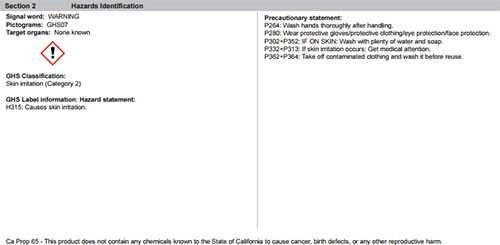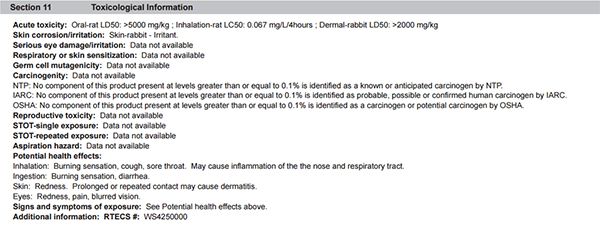How to Read & Use an SDS
Per the Globally Harmonized System (GHS) for labeling and storing chemicals enforced by OSHA, all SDSs must include 16 sections. Although the format and appearance may vary between chemical suppliers and manufacturers, all SDSs will convey the same basic information within each section.
You are responsible for understanding and maintaining up-to-date Safety Data Sheets for all chemicals in your classroom. To ensure safety information is always accessible for regular use and in case of emergency, file your SDSs in the immediate proximity of your chemical storage cabinet at all times.
This section indicates the product name as it appears on the container label. This section must also have the name, address and telephone number of the manufacturer or distributor, along with an emergency phone number. In some cases, the SDS may include commonly-used trade names, synonyms, and material uses.
A 24-hour emergency assistance Chemical Transportation Emergency Center (CHEMTREC) phone number is listed for the purpose of reporting significant emergency spills where chemicals are being transported.

This section identifies hazards associated with the listed chemical, along with any necessary warnings for those hazards. GHS requires Hazard Communication Standard (HCS) pictograms be used to convey a chemical's distinct hazards. HCS pictograms consist of a symbol on a white background framed by a red border. The nine pictograms and hazards, as described by OSHA can be found on the OSHA website here.
An SDS is required to list:
- Chemical hazard GHS classification, such as flammable liquid
- Hazard word, such as Danger or Warning
- Pictograms, symbols that represent present hazards
- Precautionary statements relative to the chemical
- Description of any additional hazards not covered by GHS classification system
- For mixtures containing ingredients with unknown toxicity, a statement describing the percentage of the ingredient in the mixture

This section identifies the ingredients of chemicals, substances, and mixtures contained in the item associated on the SDS. Information found in Section 3 includes, chemical/substance/mixture name, synonyms, Chemical Abstract Service (CAS) number, impurities, additives, and concentration.

This section gives instructions for untrained responders to provide immediate care in case of an accident. First-aid instructions are given for each possible route of exposure, along with immediate, acute and delayed symptoms. Recommendations for further treatment are given when necessary.

This section provides information about how to fight a potential fire. Recommendations for suitable extinguishing equipment are provided, along with information about any equipment that should NOT be used to fight the fire. This section also provides information about any specific hazards that may occur, such as hazardous combustion, and protective equipment that should be worn while fighting the fire.

This section provides information for responding to spills, leaks, and releases to minimize exposure to people, the environment, and property. Information will include:
- any personal precautions one should take
- any protective clothing or equipment that should be worn/used
- emergency procedures, including evacuation if necessary
- information on how to contain spill, leak, or release including methods an materials
- clean-up procedures and techniques

This section contains tips for the safe handling and storage of chemicals. Safe handling recommendations include storage and handling of incompatible chemicals, how to minimize risk of spills, leaks, or releases into environment, and hygiene tips. Safe storage recommendations include chemical incompatibility and special storage instructions, such as ventilation.

This section explains exposure limits and how to protect yourself while handling the chemical. OSHA Permissible Exposure Limits (PELs) and any other appropriate exposure limit information are provided. This section lists any personal protective equipment (PPE) recommendations, along with equipment specifications and limitations. There will also be a list of any necessary engineering controls, such as the need for ventilation.

This section provides information on physical and chemical properties of the listed chemical. A SDS must contain the following information where applicable:
- Appearance (physical state, color, ect.)
- Odor
- Odor Threshold
- pH
- Melting/Freezing Point
- Boiling Point
- Flash Point
- Evaporation Rate
- Flammability (solid/gas)
- Explosion limits: Lower/Upper
- Vapor Pressure
- Vapor Density
- Relative Density (Specific Gravity)
- Solubility(ies)
- Partition Coefficient
- Auto Ignition Temperature
- Decomposition Temperature
- Viscosity
If any of these items do not apply to or are not available for the chemical in question, a notation must be made. Manufacturers may also include any other relative information. Ward's Science SDSs also include:
- Molecular Formula
- Molecular Weight

This section identifies chemical stability, reactivity and other hazard information. Chemical stability information is provided for ambient conditions while a chemical is being stored or handled. If a chemical stabilizer is necessary or if changes in physical appearance indicate a hazard, this information will also be provided. Reactivity information will include incompatible chemicals and conditions that could potentially cause a hazardous reaction.

This section explains toxicological and health effects that could occur if chemical exposure occurs. This section is required to reveal:
- Likely exposure (inhalation, ingestion, skin contact, eye contact) or notification that the information is unknown
- Results of short - and long-term exposure, including immediate, delayed, acute, and chronic effects.
- Description of symptoms for a range of exposure levels.
- Numerical measures of toxicity, such as median lethal dose.
- Whether or not the chemical is a known carcinogen.

This section contains environmental impact information should the chemical be released into the environment. The data given may include:
- toxicity test data on both aquatic and terrestrial organisms
- potential for chemical to persist in the environment
- bioaccumulation/bioconcentration positional
- potential for groundwater contamination
- Other potential adverse effects such as ozone depletion, etc.
Section 12 is a non-mandatory section.

This section provides chemical disposal, recycling, and reclamation guidance for the chemicals and its container. This may include proper disposal container use, appropriate disposal methods, any physical or chemical properties that may affect disposal, discouragement of sewage disposal, and special precautions for landfill or incarnation disposal methods. This section may refer to Section 8 of the SDS (Exposure Control/Personal Protection).
Section 13 is a non-mandatory section.

This section includes classifications for shipping and transporting the chemical provided by USDOT and Transport Canada, along with any special precautions that should be taken when shipping the chemical.

This section provides information about safety, health, and environmental regulations not located in other sections of the SDS. This will include national and regional regulations that apply to the chemical.

This section provides information on when the SDS was created and/or the data of the last revision. There may also be details on what has changed since the previous version was released. Any other information the manufacturer wishes to convey that does not fit into other sections will be included in this section.
